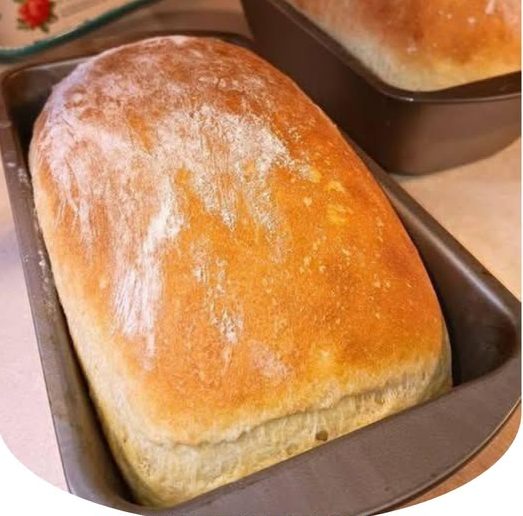Introduction
Bread is a staple in many households, but once you experience the joy of making your own, you might never go back to store-bought versions. This homemade bread is easy to make, requires minimal ingredients, and delivers a soft yet sturdy texture perfect for sandwiches, toast, or dipping into soups. Plus, the aroma of freshly baked bread filling your home is an added bonus!
Origin and Cultural Significance
Bread has been a fundamental part of human civilization for thousands of years, dating back to ancient Egypt. Different cultures around the world have their own variations—baguettes in France, focaccia in Italy, and sourdough in San Francisco. Homemade bread represents a return to traditional baking, allowing control over ingredients while embracing an old-fashioned yet rewarding practice. The simplicity of this recipe makes it accessible to anyone, whether a seasoned baker or a beginner.
Ingredients Quantity
Basic Bread Dough:
- 4 cups all-purpose or bread flour
- 1 ½ cups warm water (about 110°F or 45°C)
- 2 ¼ teaspoons (1 packet) active dry yeast
- 2 tablespoons sugar or honey
- 1 ½ teaspoons salt
- 2 tablespoons olive oil or melted butter
Optional Additions
- Seeds & Nuts: Sprinkle sesame, poppy, or sunflower seeds for added texture.
- Herbs & Spices: Add dried rosemary, garlic powder, or thyme for flavor.
- Whole Grains: Substitute half the flour with whole wheat flour for a heartier texture.
- Cheese & Garlic: Incorporate shredded cheese and minced garlic for a savory twist.
Tips for Success
- Use Fresh Yeast: Ensure your yeast is active by proofing it in warm water with sugar. It should bubble within 5-10 minutes.
- Knead Well: Kneading the dough for at least 8-10 minutes develops gluten, resulting in a soft but structured loaf.
- Proper Rising Time: Let the dough rise in a warm, draft-free area for about an hour or until doubled in size.
- Don’t Overbake: Bake until the crust is golden brown and the loaf sounds hollow when tapped.
- Cooling Matters: Allow the bread to cool before slicing to prevent it from becoming too dense or gummy.
Instructions
Step 1: Activate the Yeast
- In a bowl, combine warm water, sugar (or honey), and yeast. Stir and let sit for 5-10 minutes until foamy.
Step 2: Make the Dough
- In a large bowl, combine flour and salt. Add yeast mixture and olive oil (or butter). Stir until a dough forms.
Step 3: Knead the Dough
- Transfer to a floured surface and knead for 8-10 minutes until smooth and elastic.
Step 4: First Rise
- Place dough in a greased bowl, cover with a towel, and let rise for 1 hour or until doubled in size.
Step 5: Shape the Dough
- Punch down the dough, shape it into a loaf, and place in a greased bread pan. Cover and let rise for another 30 minutes.
Step 6: Bake the Bread
- Preheat oven to 375°F (190°C). Bake for 25-30 minutes until golden brown.
Step 7: Cool & Enjoy
- Let the bread cool for at least 20 minutes before slicing.
Description
This homemade bread is light, fluffy, and has a perfectly crisp crust. It’s soft on the inside, making it ideal for toast, sandwiches, or simply slathering with butter. The aroma of freshly baked bread is unmatched, and each bite brings warmth and comfort.
Nutritional Information (Per Slice, Approximate)
- Calories: 150
- Carbohydrates: 28g
- Protein: 4g
- Fat: 3g
- Fiber: 1g
- Sugar: 2g
Conclusion
Making homemade bread is an incredibly rewarding experience, both in flavor and satisfaction. This simple, foolproof recipe will convince you that store-bought bread just doesn’t compare. Whether you’re new to baking or a seasoned pro, this bread will become a staple in your kitchen.
Recommendation
Enjoy this bread fresh out of the oven with butter, use it for sandwiches, or toast it with your favorite spreads. It also pairs well with soups, stews, and hearty meals. For a fun twist, try incorporating herbs, cheese, or seeds into the dough!
Embracing Healthful Indulgence
By baking your own bread, you eliminate unnecessary preservatives and additives found in store-bought loaves. This recipe allows you to control the ingredients, ensuring a healthier, more natural alternative. Plus, the act of baking itself can be a therapeutic, joyful experience—one that connects you to tradition, creativity, and nourishment.
